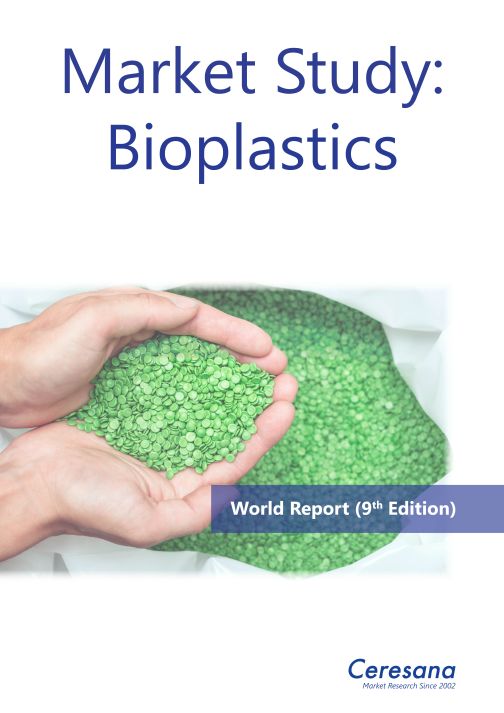Will there soon be more plastics than stones? The triumph of polymers is unstoppable: The world’s plastic consumption doubles approximately every 20 years; in the emerging markets of Africa and Asia, it is even expected to triple. Bioplastics are benefiting from this boom: There are “green” alternatives to plastics made from crude oil or natural gas for an increasing number of applications. To reduce the ecological footprint, even petrochemical products are increasingly being mixed with biomass. The latest and already ninth edition of Ceresana’s bioplastics market report anticipates further growth: Market researchers forecast that the global bio-based and biodegradable plastic market size will reach around USD 12 billion by 2034.
Compost Soil Instead of Waste Crisis
The environmental impact of this ubiquitous wonder material is a challenge. Even in comparatively environmentally conscious Europe, the majority of the around 42.5 million tonnes of plastic waste generated there each year is still incinerated or landfilled – only around 20% is recycled. According to a new report by the EU’s Joint Research Centre (JRC), around 3.7 million tons of plastic waste are “lost in the environment” in Europe every year, mainly due to littering, mismanagement, and textile washing: Almost 6% of all European plastic consumption ends up in the ground or water. To remedy this, the EU researchers recommend more recycling – but also more bioplastics. The new EU packaging regulation (PPWR) now stipulates for the first time that all packaging must soon be reusable or recyclable, and in certain cases also compostable. The EU Commission is working on binding quotas for the use of bio-based raw materials. The industry is eagerly awaiting the new “EU Bioeconomy Strategy”, which is planned for the end of 2025, and the “Circular Economy Act”, which is due in 2026. To date, however, most biopolymer materials have not been produced in Europe, but in Asia-Pacific. Ceresana expects this region of the world, which has sugar cane and other low-cost biomass raw materials at its disposal, to see the highest growth in the coming years. In addition to market data and forecasts, the study also contains information on the regulatory framework as well as on the general economic environment and the situation in the packaging industry (including key companies, market size, recycling rates) in each country.
Innovations for Sustainable Applications
The packaging industry is the largest consumer of plastics today. The advantages of the following bioplastics, which are currently by far the best-selling materials, are particularly evident in flexible packaging: Polylactic acids (PLA) and starch polymers (especially TPS) offer higher permeability, biodegradability, and a good “green” image among consumers. For the starch-based bioplastics and polylactic acid market, Ceresana’s latest market report expects further volume growth of 7.7% per year until 2034. For bio-based but non-biodegradable plastics, such as bio-polyethylene, bio-PET, or bio-PA, growth is expected to be lower at 5.3% per year. Like conventional petrochemical plastics, the various polymers made from biogenic raw materials each have areas of application for which they are particularly well suited. Biocompatibility, for example, is an advantage for medical implants. Compostability is required for agricultural films and flower pots. In 3D printing, bio-filaments are valued not least because they do not smell of burnt plastic. The analysts at Ceresana are currently registering the highest growth rates for innovative bioplastics in the automotive and electronics sectors.
Current Global Bioplastics Market Report:
Chapter 1 of the new market study provides a comprehensive presentation and analysis of the global bioplastics market with forecasts up to 2034: The development of demand (in tonnes), revenues (in USD and EUR), and production (in tonnes) is shown for each region. In addition, these application areas of bioplastics are examined individually: rigid packaging, flexible packaging (bags, sacks, pouches), other flexible packaging, consumer goods, automotive and electronics, other applications. The production of bioplastics is broken down for the product groups: polylactic acid (PLA), starch-based plastics, other biodegradable plastics, non-biodegradable plastics. Demand for bioplastics per region is also broken down for the various types of plastic, including: polyhydroxyalkanoates (PHA), polybutylene adipate terephthalate (PBAT), bio-polyethylene (bio-PE).
In Chapter 2, the 11 most important bioplastic sales markets are examined individually: France, Germany, Italy, Spain, the Netherlands, United Kingdom, USA, China, Japan, South Korea, and Taiwan. The following are shown in each case: Demand and revenues, demand for the individual application areas, and demand per type of plastic.
To give an overview of the bioplastic industry, chapter 3 provides useful company profiles of the largest bioplastic manufacturers, clearly arranged according to contact details, revenues, net income, product range, production sites, and profile summary. Detailed profiles of 60 bioplastic manufacturers are supplied, such as BASF, Evonik, Cargill, Eastman, FENC, Hengli, Mitsubishi Chemical, PTT GC, and TotalEnergies.
Further Information on the market study “Bioplastics – World” (9th edition): https://ceresana.com/en/produkt/market-study-bioplastics

About Ceresana
As one of the world’s leading market research institutes, Ceresana specializes in the plastics, chemicals, packaging, and industrial goods sectors. One particular focus is the bio-economy: Ceresana has been supporting the dynamically growing circular economy for more than a decade with market analyses and forecasts on bio-based products and biodegradable materials. More than 250 market studies provide more than 10,000 customers around the world with the knowledge base for their sustainable success. With the digital event series “Future of Bio”, Ceresana is creating a platform for experts and specialists to exchange knowledge, utilize synergies, and jointly drive the future of the bio-economy forward. Learn more about Ceresana at www.ceresana.com
Let’s meet! The new Ceresana event series on the future of the bio-economy continues. The online event “Future of BioPackaging” will take place on October 28 and 29, 2025: https://ceresana.com/en/events/future-of-biopackaging
Ceresana
Mainaustrasse 34
78464 Konstanz
Germany
Press Contact: Martin Ebner, m.ebner@ceresana.com
